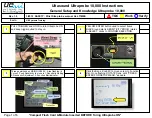
Judgment criteria on machine tool spindles (ISO 17243)
C -
3
Vibration velocity parameter
The vibration velocity parameter is measured as the broadband vibration magnitude in
mm/s RMS
, typically within the frequency range of 10 Hz to 5 kHz.
The vibration velocity parameter can be used as an indication of long term spindle
condition (LTSC).
The typical frequency range of 10 Hz to 5 kHz ensures that low frequency vibrations
from building movements, etc. are removed from the signal but still any unbalance
vibration (1 × running speed) from a 600 r/min spindle would be within the selected
frequency band. On the high end, the 5 kHz upper frequency limit allows for multiple
speed harmonics (as would be produced by, for example, a loosely mounted spindle)
on a 30 000 r/min spindle to be reflected in the evaluation parameter.
•
Vibration acceleration parameter
The short-term vibration acceleration parameter is intended to reflect problems that
might lead to a catastrophic failure of the spindle within a reasonable short time
period, in most cases, ranging from days to six months.
The vibration acceleration parameter is measured as broadband vibration magnitude
in
m/s
2
RMS
; typically within the frequency range of 2 kHz to 10 kHz.
The vibration acceleration parameter can be used as an indication of short-term
spindle condition (STSC).
Spi ndle cl assification
Classification according to rated power
Direct-driven spindles and belt-driven spindles are divided into
spindles with rated power ≤ 5 kW, and
spindles with rated power > 5 kW
Classification according to maximum spindle speed
Four speed ranges are defined, with respect to spindle maximum speed, expressed in
r/min:
Speed range 1, SR1
600 < SR1
≤ 6 000
Speed range 2, SR2
6 000 <
SR2 ≤ 12 000
Speed range 3, SR3
12 000 <
SR3 ≤ 18 000
Speed range 4, SR4
18 000 <
SR4 ≤ 30 000
Note:
Spindle speed only affects the vibration evaluation zone boundaries for
STSC
(vibration acceleration) and does not affect the zone boundaries for the
LTSC
(vibration velocity)
Classification according to bearing type
Spindles are divided according to the following bearing types:
ball bearings (point contact);
roller bearings (line contact).
Содержание N330
Страница 2: ......
Страница 8: ...6 Index Empty page...
Страница 18: ...2 4 General layout Empty page...
Страница 24: ...4 4 OVERALL vibrometer mode Empty page...
Страница 28: ...5 4 1xRPM vibrometer mode Empty page...
Страница 34: ...6 6 FFT mode Fast Fourier Transform Empty page...
Страница 50: ...8 8 SPINDLE ANALYSIS mode Empty page...
Страница 90: ...11 20 Rotors balancing mode Empty page...
Страница 104: ...13 12 Setup mode Empty page...
Страница 110: ...14 6 General purpose functions Empty page...
Страница 124: ...C 6 Judgment criteria on machine tool spindles ISO 17243 Empty page...
Страница 156: ...G 10 Balancing accuracy of rigid rotors Diagram 2 diagram for fine drilling 0 5 1 5 mm...
Страница 157: ...Balancing accuracy of rigid rotors G 11 Diagram 3 diagram for fine drilling 1 6 mm...
Страница 158: ...G 12 Balancing accuracy of rigid rotors Diagram 4 diagram for fine drilling 2 10 mm...
Страница 159: ...Balancing accuracy of rigid rotors G 13 Diagram 5 diagram for fine drilling 5 12 mm...
















































